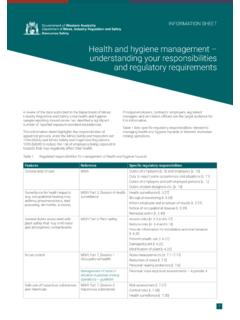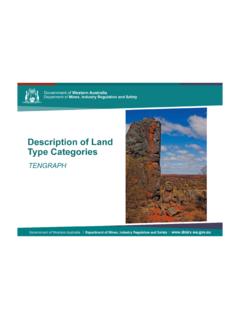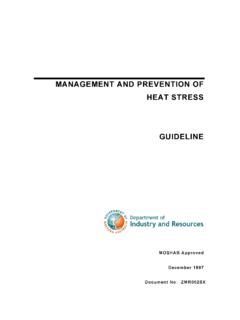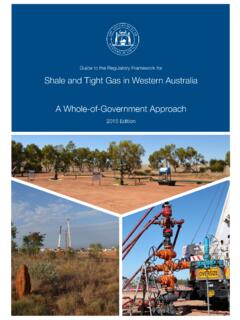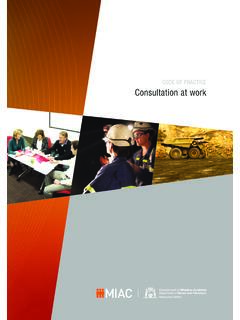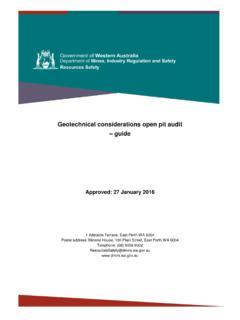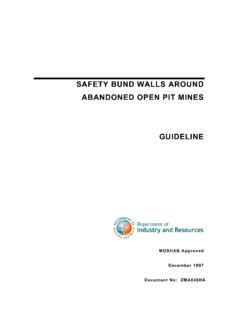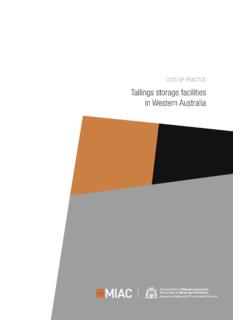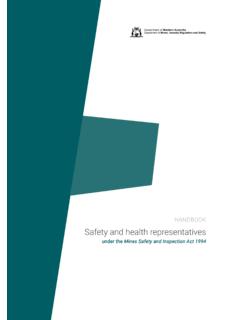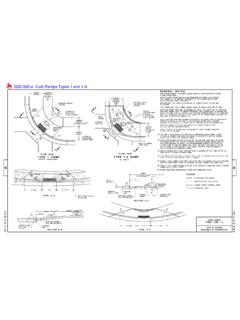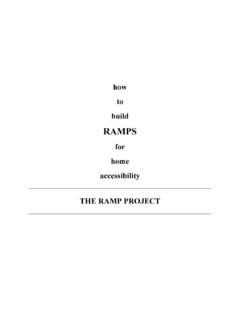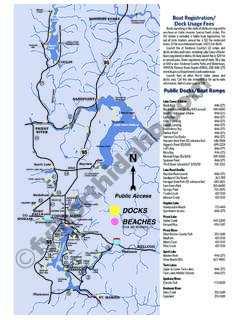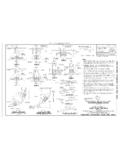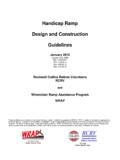Transcription of Fauna Egress Matting and Ramps
1 Department of Mines and Petroleum, Mineral House, 100 Plain Street East Perth, WA 6004 Tel: +61 8 9222 3333, Fax: +61 8 9222 3862, Email: Web: Fauna Egress Matting and Ramps Environmental Notes on Mining, updated March 2012 What are Fauna Egress Matting and Ramps ? Fauna Egress Matting and Ramps are put in place to allow trapped wildlife to escape from HDPE (High Density Poly Ethylene) lined ponds which are commonly used on mine sites (process water ponds, turkey s nests, evaporation ponds, sedimentation ponds are examples). Why is it required? The majority of mine sites in Western Australia occur in a dry environment and water sources on mine sites tend to attract animals.
2 Steep sided and wet slippery pond walls make it difficult for trapped animals to escape from ponds resulting in unnecessary impact on Fauna . In their attempt to escape animals can also damage the pond liner and associated infrastructure (Plate 2). Dead animals can also result in the blocking of pump inlets/outlets ( Solar salt operations). Department of Mines and Petroleum, Mineral House, 100 Plain Street East Perth, WA 6004 Tel: +61 8 9222 3333, Fax: +61 8 9222 3862, Email: Web: Plate 2: damaged liner from Fauna attempting to climb the pond wall. How to minimise the problem? Earth lined structures are the safest for animals to access water.
3 If a liner is required it may be feasible to have sections of the ponds lined with earth and/or at a lesser angle to allow for safer ingress and Egress from the pond. Batter angles of 30-35 degrees from the horizontal are recommended for ponds. In some instances ponds may be fenced and/or netted to exclude some or most wildlife. (Plates 3: bird netting and fence with shade cloth, Plate 4: electric fencing and rigid overhang to deter small wildlife from entering a salt water flume). If large animals are deterred by suitable fencing the Egress mat only needs to be suitable for smaller sized Fauna ( snakes, lizards, small mammals).
4 Department of Mines and Petroleum, Mineral House, 100 Plain Street East Perth, WA 6004 Tel: +61 8 9222 3333, Fax: +61 8 9222 3862, Email: Web: Plate 3: HDPE pond netted and fenced to exclude wildlife (Fortescue Metals Group, Cloudbreak). Plate 4: Water flume, electric fence and overhang to deter Fauna , (Shark Bay Salt JV). Department of Mines and Petroleum, Mineral House, 100 Plain Street East Perth, WA 6004 Tel: +61 8 9222 3333, Fax: +61 8 9222 3862, Email: Web: What works? Feedback from various WA mine sites, consultants and DMP Inspectors indicates that the following options seem to perform the best: 1.
5 Earth/rock Ramps 2. Large diameter rope (for small mammals/reptiles) 3. Large weave shade cloth weighed down and reinforced with conveyor belt Matting and anchored securely with metal bar and chain at top end to avoid twisting. Needs anchoring at lower end as well. 4. Wooden pallets linked together 5. Used tires linked together 6. Cyclone mesh fencing weighed down and anchored securely. For example tied securely to conveyor belt Matting using C cleats and tek screw or plastic zip cable ties (refer to front cover picture and plate 5). 7. Logs or large planks of wood.
6 Plate 5: Example of successful Fauna Egress using conveyor Matting and a mesh stripe which is firmly secured to the Matting with cable ties (BC Iron Nullagine Pty Ltd). Department of Mines and Petroleum, Mineral House, 100 Plain Street East Perth, WA 6004 Tel: +61 8 9222 3333, Fax: +61 8 9222 3862, Email: Web: Various materials that have been tried and pro and cons are listed in table 1: Material used Pros Cons Shade cloth weighed down with used conveyor belt Matting , metal chain/bar as spreader at top. Anchored at the bottom of pool. Relatively cheap, conveyor Matting usually available on sites, use of waste material for conveyor Matting .
7 Needs maintenance and good anchoring and bracing to avoid twisting. Concrete reinforcing mesh, weld mesh, cyclone type fencing. Strong enough to support large animals. Proven to be effective at a Pilbara mine site. Expensive, may tear the liner. Can be lined with shade cloth or attached to wooden planks or conveyor belt Matting to avoid that issue. Heavy. Can rust depending on mesh used. Linked used tyres Readily available on sites, use of waste material. May not work for smaller Fauna , heavy, requires strong anchoring points. Jute Matting & Geotextile Matting . Cheap, lightweight, can come in long lengths.
8 Limited lifespan for natural based product. Some types are reinforced with synthetic fibres which become a trap for bird feet/small animals. Not strong enough to support large animals. Needs anchoring at the base to stop bottom section floating in the pond. Linked used wooden pallets Readily available on sites, use of waste material. May tear the liner, need strong anchoring points, heavy. Large diameter rope. Effective to allow small Fauna Egress from ponds ( reptiles, small mammals) Not useful for larger Fauna . Limited lifespan for natural product derived ropes. Needs anchoring at the base to stop bottom section floating in the pond.
9 Wooden planks, logs Effective. Logs not readily available in the arid zone, may damage the liner. Heavy. Netlon mesh products (4-25mm mesh sizes) used in aquaculture related products Can be welded to HDPE, lightweight. Not strong enough to support large animals. Linked used rock core sample trays Lightweight. Can be weighed down with core samples Expensive, site geologist may object. Department of Mines and Petroleum, Mineral House, 100 Plain Street East Perth, WA 6004 Tel: +61 8 9222 3333, Fax: +61 8 9222 3862, Email: Web: Other considerations Use of contrasting colours White is used in commercial products designed for the emergency Egress of pets from swimming pools because all animals can see that colour.
10 What is the trapped animal likely to see at the pond s water level? Consider using a colour that contrasts against the black colour of the HDPE lining. Floating pontoons Pontoons may be of use for birds to recover and avoid predators by flying out rather than climbing out of the pond. Placement of the mat or Ramps In general the corners of ponds provide the lowest angled slopes, tend to act as a funnel to direct trapped wildlife and are the best locations to provide Egress Matting . For large ponds additional mats should be placed at regular intervals between corner locations.
